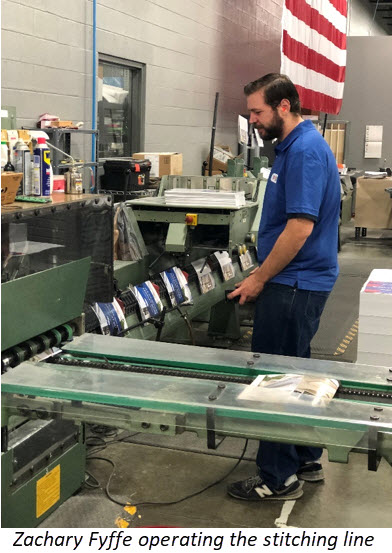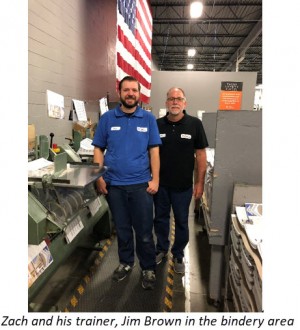 By John Berthelsen, PGSF
By John Berthelsen, PGSF
Service providers and industry suppliers across the country have identified recruitment and replacement of aging employees as a major concern. I have written about this in the past and will continue to address it in the future. Presented here is a case study on how one highly successful organization, Think Patented in Dayton, Ohio has addressed the problem. Their educational and development programs are designed to incorporate real-world work experience and learning into the experience of their employees and prospective employees. This practical experience combines a holistic and realistic understanding of the business world, and specifically the graphic communications industry.
The Think Patented Apprenticeship Training Program is designed to prepare individuals for occupations in all phases of our industry from creative to digital and offset printing through products and fulfillment. The 1-year program combines structured on-the-job training – supervised by experienced employees – with related instruction at local learning institutions. The Apprenticeship Program provides hands-on training to those who are interested in working in the industry. Successful completion indicates the Apprentice’s ability to run specific machinery and equipment within the plant and provides the Company the ability to assess the Apprentice for plant supervision and management positions for the future.
Apprenticeship Background
America has a serious skilled trades shortage. Thousands of high-paying jobs are going unfilled and companies are recognizing competition for employees from all sides. Think Patented was experiencing this issue first hand as it struggled to fill key production positions. They determined that the best way to find qualified and motivated workers for its production lines was to create them themselves. So, to define the future of their business, they looked into the past.
While “on-the-job training” is still common in medical and similar fields, apprenticeships are all but forgotten in today’s high-tech, automated production companies. But there was once a time when every woodworker, machinist, horse trainer, shop keeper, attorney, or accountant would take on apprentices who, usually without formal education, learned the job from the masters to become the next generation of professional, skilled tradespeople.
Think Patented’s Apprenticeship Training Program is designed to prepare individuals for occupations in all phases of graphic communications. From creative development to production operations and on to quality control and fulfillment. Building a highly skilled and dedicated workforce is vital to the survival of any industry, and ours is no different. Rather than wait for the industry, educators, or the government to find a solution, they did it themselves.
Many industries have dropped training programs because they believe the cost outweighs the benefits. It is their contention that this could not be further from the truth. Given the extreme expense of searching for already skilled employees and paying advanced wages only to find that they are the wrong fit, the cost benefit of an apprenticeship becomes crystal clear.
 Zachary Fyffe becomes first graduate apprentice
Zachary Fyffe becomes first graduate apprentice
Zachary Fyffe started as a temporary production employee in October of 2015. After demonstrating an uncommon style and work ethic he was brought into the newly-created apprenticeship program less than six months later. Originally, he was brought in just to load the stitching machine, moving materials around and packing. After two years of training, he has a full-time, highly skilled position doing full set-ups, maintenance, and quality control.
The program was created partly out of necessity and partly because it seemed the ideal scenario for Zachary’s talents. He would be the test case, giving him a unique opportunity to help the company develop a plan to train needed talent, giving them a personal stake in the success of our company.
In the first four months of his new program, Zachary was tasked with learning the proper way to load pockets on the stitcher, followed by an equal amount of training time on how to set up the pockets and cover deck. Over the next 16 months, Zachary was taught how to set up and time the trimmer / stitching unit / chain and stacker. By the end of his last year, he had also been taught how to do knife changes and perform other maintenance on the machine and is now fully trained in its operation.
During the program, Zachary worked with 2 skilled operators with more than 35 years of combined experience on the stitching equipment. Jim Brown, Post Press Manager, has been Zachary’s supervisor throughout this process. After 19 years with Think Patented, Jim’s experience was vital to the success of this program. As Zach advanced through each stage of his training, he was evaluated, at first informally and later with more specificity. His progression to the next stage was dependent on his performance in mastering each level.
Along with Jim and the two other operators, Zach worked with many other people from within the company. An apprenticeship is not just about mechanical operations and proper quality checks, it’s about people and how well they suit the job and adapt to the company culture and surroundings – and their fellow workers. Zachary says that there was no better place to work and was excited about the program from the onset. His attitude, even when he made mistakes, was positive and motivating for himself, his coworkers and his supervisors.
 Where Do We Go from Here?
Where Do We Go from Here?
Zachary is set for a lifelong career, if he so chooses, the result is a well-trained, dedicated, Think Patented employee. It’s a win-win for all sides! Other companies can follow this concept and implement similar programs. Suttle-Straus in Waunakee, Wisconsin has started a similar program within the past year and expects similar results. Both Niels Winther and Ted Straus support sharing of this concept and are happy to chat with others about its benefits.
Implementing an apprenticeship program is one of many ways to build your future workforce. Visit the Print and Graphics Foundation website at www.pgsf.org to learn more. And, consider supporting the important work that the Foundation’s doing to assist in creating the workforce of tomorrow.
************************
PGSF works to inform young people about the opportunities that are available in the graphic arts industry and then support them during their educational phase. In 2018, 220 students were granted a total of $500,000 in scholarships. Less than 20% of revenues go towards expenses at the Foundation. All endowed scholarships are kept in trust and remain perpetual. To learn more about PGSF, or how you can support its work, visit www.pgsf.org or contact John Berthelsen at [email protected]. PGSF is a 501(c)3 non-profit organization and contributions are tax-deductible to the extent allowed by law.


Prefer to comment without registration? Click in the Name field and select "I'd rather post as a guest"